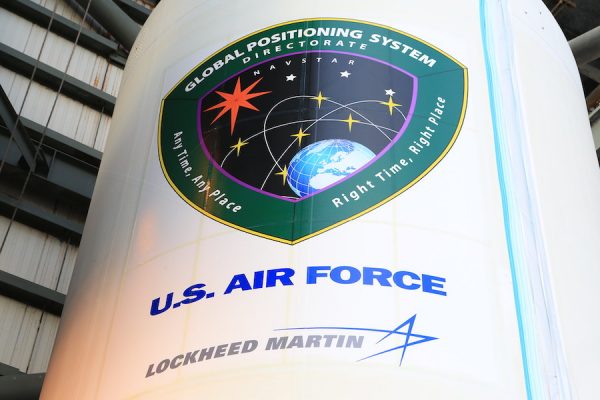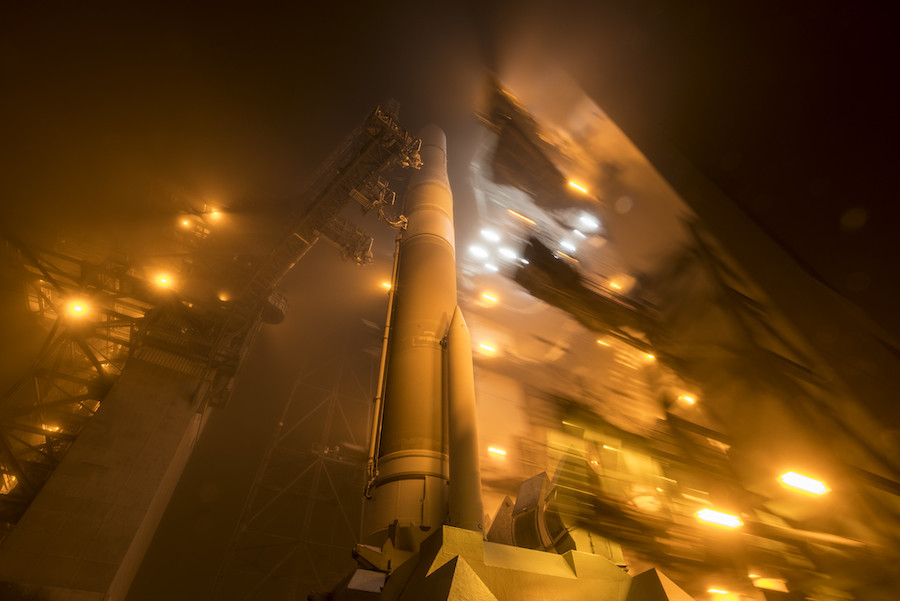ULA’s second launch of the month scheduled for Thursday – Spaceflight Now

Weather forecasters expect a 70 percent chance of favorable conditions at Cape Canaveral for liftoff of a United Launch Alliance Delta 4 rocket Thursday with a GPS navigation satellite, marking the last flight of the Delta 4’s single-core variant after 29 flights since 2002.
The mission’s 27-minute launch window opens at 9 a.m. EDT (1300 GMT) Thursday. The Delta 4 rocket will take off from Cape Canaveral’s Complex 37 launch pad and head northeast with the second of a new generation of GPS navigation satellites for the U.S. Air Force.
The launch scheduled for Thursday comes two weeks after ULA’s most recent flight from Cape Canaveral, which used an Atlas 5 rocket to deliver an Air Force communications satellite into orbit.
An early weather outlook issued by the Air Force’s 45th Weather Squadron on Monday predicts a 70 percent chance of acceptable conditions for launch Thursday.
Forecasters expect a typical summertime weather pattern over Central Florida this week, with scattered thunderstorms driven by the afternoon sea breeze. The mobile service tower, which protects the Delta 4 at pad 37, will be retracted Wednesday night in preparation for fueling of the launcher with super-cold liquid hydrogen and liquid oxygen propellants.
“Sufficient moisture and light steering flow should trigger isolated showers and storms over the Atlantic waters early Thursday morning,” forecasters wrote. “While light winds will keep most of this activity offshore, a shower approaching the coast and/or flight path cannot be ruled out.”
The primary weather concerns during Thursday’s launch window are with the possibility of violating the cumulus cloud and flight through precipitation rules, according to the forecast issued Monday.
During Thursday’s launch window, forecasters predict isolated rain showers offshore, partly cloudy skies, south-southeast winds of 8 knots, and a temperature of 83 to 85 degrees Fahrenheit.
Final pre-launch milestones planned this week include a launch readiness review scheduled for Tuesday. Workers at pad 37 will complete final closeouts on the rocket Wednesday before moving the mobile gantry to reveal the Delta 4 ahead of fueling.
The 207-foot-tall (63-meter) Delta 4 rocket will climb away from pad 37 with 1.1 million pounds of thrust from a hydrogen-fueled Aerojet Rocketdyne RS-68 main engine and two strap-on solid rocket boosters built by Northrop Grumman Innovation Systems.
Heading toward the northeast, the Delta 4 will surpass the speed of sound in less than a minute and jettison its twin solid rocket boosters at T+plus 1 minute, 40 seconds.
The RS-68 core stage engine will shut down at T+plus 3 minutes, 55 seconds, followed by stage separation roughly seven seconds later. An RL10 engine on the Delta’s upper stage, also built by Aerojet Rocketdyne, will ignite for the first of two firings required to place the GPS satellite into an elliptical transfer orbit.
The Delta 4’s payload fairing will jettison in a clamshell-like fashion at T+plus 4 minutes, 26 seconds, once the rocket soars into the rarefied upper atmosphere. The shroud protects the GPS payload during launch preparations and the ascent through the lower layers of the atmosphere.
The RL10 upper stage engine will switch off at T+plus 13 minutes, 33 seconds to reach a preliminary orbit. Restart of the RL10 engine is planned nearly 67 minutes after liftoff for a three-and-a-half-minute burn to inject the GPS spacecraft into an egg-shaped transfer orbit ranging between 745 miles (1,200 kilometers) and 12,542 miles (20,185 kilometers) above Earth, with its orbital plane tilted 55 degrees to the equator.
The Lockheed Martin-built GPS satellite will separate from the Delta 4 launcher at T+plus 1 hour, 55 minutes.
The GPS 3 SV02 navigation satellite, nicknamed “Magellan,” will use its own engine to circularize its orbit and join the GPS constellation some 12,550 miles above the planet, where ground teams will test the new spacecraft and put it into service to replace an aging member of the constellation.
The GPS network provides positioning and timing services worldwide for military and civilian users, beaming signals relied upon by airliners, ATMs, drivers and smart bombs, among numerous other users.
The satellite set for launch Thursday is the second in a new generation of GPS satellites, providing more accurate navigation signals and boasting longer design lifetimes. The new satellites are also compatible with other space-based navigation networks operated by Europe, Japan and China.
The first off the new series of GPS spacecraft launched in December aboard a SpaceX Falcon 9 rocket.

The Delta 4 launch Thursday will be be the final flight of the Delta 4-Medium rocket variant, which flies with a single first stage booster, with additional thrust provided by strap-on solid rocket boosters.
The Delta 4-Heavy rocket configuration, made by combining three Delta 4 rocket cores together, will continue flying into the 2020s. The National Reconnaissance Office, using the Air Force as a contracting agent, has contracts in place for at least five more Delta 4-Heavy missions through 2024.
ULA decided in 2014 to retire the Delta 4-Medium configuration because it is more expensive than the company’s Atlas 5 rocket. The two rocket families are also largely redundant, but ULA kept the Atlas and Delta lines flying to ensure the Air Force had two rocket options to get military payloads into space.
There is no heavy-lift variant of the Atlas 5 rocket, so the Delta 4-Heavy will continue to fly into the 2020s, until ULA’s next-generation Vulcan launcher is operational.
The retirement of the Delta 4-Medium rocket also marks the last flight of the Delta 4’s 4-meter-diameter (13.1-foot) payload fairing. The Delta 4-Heavy rockets set for launch over the next five years all use a larger 5-meter (16.4-foot) payload shroud.
SpaceX’s Falcon 9 and Falcon Heavy rocket are now certified to fly the military’s national security satellites, providing the Air Force with a second family of launch vehicles alongside the Atlas 5 and Delta 4-Heavy.
Email the author.
Follow Stephen Clark on Twitter: @StephenClark1.






